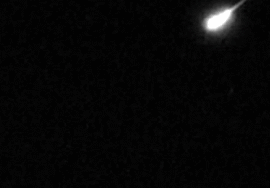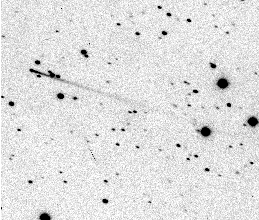|
back to spaceweather.com "The Geminids of mid-December are one of the best annual meteor showers," says Bill Cooke of the NASA Space Environments Team at the Marshall Space Flight Center. Geminid meteors are bright, plentiful, and sky watchers can see them from both hemispheres. And that's not all... "I enjoy the Geminids because they come from the Twilight Zone," he laughs.
Right : Amateur astronomer George Varros photographed this Geminid fireball on Dec. 7, 2002. "It was as bright as Venus," says Varros. [more] The source of the Geminid shower is an object called 3200 Phaethon. Discovered in 1983 by NASA's Infrared Astronomical Satellite, Phaethon shares its orbit with the Geminid meteoroids. Furthermore, it is about the right size to be a comet. So far, so good... But 3200 Phaethon doesn't act like a comet, says Cooke. "3200 Phaethon doesn't sprout a tail when it comes close to the Sun. It doesn't have a halo or a coma ... in fact, based on its orbit and the way it reflects sunlight, it seems much more like an asteroid." Perhaps, he speculates, it's a little bit of both. "It has become quite obvious in recent years that our nomenclature in astronomy is not keeping pace with our discoveries. We like to place objects in neat well-defined categories even though Mother Nature makes no such distinctions. For instance, is Pluto a planet or a Kuiper-belt asteroid? When does a Jupiter-like planet become a brown dwarf?" Likewise, he asks, "after a comet has gone around the Sun so many times that its ices are exhausted, so that it no longer has a tail or a coma, is it still a comet? Or do we re-classify it as an asteroid?"
Left:Something else from the Twilight Zone? In 1996, asteroid Elst-Pizarro briefly sprouted a tail and looked much like a comet. Learn more about it in an earlier Science@NASA story " The Baffling Geminid Meteor Shower ." An asteroid, a comet, a comet corpse? The meteors are lovely no matter what. Geminid meteors stream out of the constellation Gemini--hence their name. Try looking for them on Saturday, Dec. 13th, between 10 p.m. local time and midnight. During those hours the moon won't be too high or glaring, and you should be able to spot dozens of meteors. |

